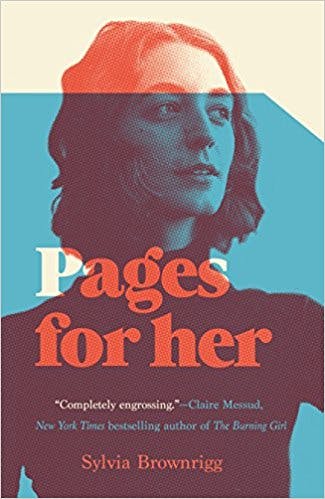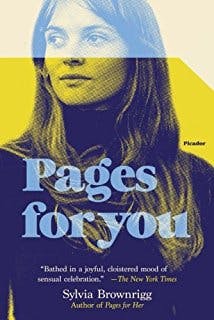Flannery Jansen is 17 years old, a gangly freshperson at Yale. One morning she stops at a diner, where she orders a jelly omelet. She orders the jelly omelet in the spirit of adventure, of trying the delicacies that the East has to offer. The omelet is disgusting. A green-eyed woman across the room looks up from her book to laugh. She is a graduate student named Anne. Flannery falls in love.
So begins Sylvia Brownrigg’s 2002 novel Pages For You, which won a Lambda Literary Award that year. It is a novel about lesbian sexual awakening told with deep sympathy and respect for its hero, even though that hero is so half-formed that she’s barely autonomous. Flannery is awkward (the jelly omelet is laughable), and her affair with the 28-year-old Anne is clearly doomed to be short-lived, but Brownrigg distinguishes herself by taking every moment of their relationship seriously.
The sexual infatuations of teenagers are usually the stuff of a protagonist’s memory, a cog in the machine of their motivations. And, when they crop up in fiction, lovestruck students are more often used as obstacles in the paths of their professors, stray shrapnel threatening to bring down careers. The adolescent narrator does not usually get to be a real hero at all; once they are no longer 17, a person is likely to write off all that 17-year-old people experience, feel, suffer. By dwelling right inside that first moment of internal blooming—the first love, the sensations of new sex, its inevitable disappointments—Brownrigg did something marvelous in Pages For You.
Now, 15 years later, there is a sequel: Pages For Her. It is Brownrigg’s seventh work of fiction (she also wrote the children’s book Kepler’s Dream under a pseudonym). Californian by birth, Brownrigg attended Yale as an undergraduate—the same college that acts as the backdrop for Flannery’s sexual awakening.
The new novel is set a full 21 years after Pages For You (which is to be re-released this summer). Anne and Flannery are middle-aged, pushing 40 and 50, respectively. Each has partnered with a man in the in-between years. Crucially, however, Flannery has a child; Anne has none.
Brownrigg denies her characters the family-building decades, skipping the most picturesque years of a coupling—the thirties-ish, domestic years. Instead, the two books give us only the years in these women’s lives that they spend together, the “pre” and the “post” of the story we might expect.

Flannery’s husband is a nice man who just happens to expect her to do everything to take care of their child and home. Years prior to Pages For Her’s action, Flannery had great success with her debut novel, which featured an extremely well-realized sex scene in the desert that had her lesbian protagonists picking cactus needles out of their flesh afterward. When Flannery receives an invitation to talk about her fiction at a conference at Yale, she spies Anne’s name on the list of attendees. The two women do not meet until the book is very nearly over. We see them twist and turn through their lives, memories, relationships, and fantasies until, at last, they come together.

Anne’s relationship with a man named Jasper was a key element of Pages For You. Pages For Her describes how Flannery’s love for Anne continued across the years of their separation. Her obsession undimmed, she nevertheless thought of the Anne-and-Jasper unit with a strange sort of affection. The knowledge that her lost love was in a happy heterosexual relationship provided Flannery with consolation. In these details, Brownrigg so accurately depicts the experience of women who love both men and women that it is downright uncanny.
As most bisexual women know, to be a woman in love with a woman who is in love with a man is to be in a tricky spot. No matter how authentic the connection with your lover or ex, the hetero-partnered woman will always have a certain type of power on her side. When Flannery first gets together with her eventual husband, Charles, she observes with shock the ease with which she can move through the world. “[S]he was a tourist of a foreign lifestyle: fancy restaurants, art openings, heterosexuality. So this is how they live!” This power takes the form of invisibility. For Flannery, who “had always hated to be watched or even noticed as two women together tended to be (the familiar stranger’s double-take: Which one is the… oh, they both are!), this was an unexpected reprieve.”
In conveying the experience of bisexuality, as well as the emotional reflection on that experience, Brownrigg is humane and smart enough to be funny even where the subject is, underneath the surface, painful. Flannery can laugh at her new ease, be sweet about her lover’s boyfriend. As Flannery walks down the street with her man, she “felt as though she had been permitted into one of those country clubs she had previously considered snooty and boring, but it had turned out to be good fun (they had an air hockey table!)”. Flannery’s new straightness “made her feel older,” her new sense of self mixed up with the ritual of mating. “At last she was introduced to the way Regular People coupled. Partnered. Made love. This club had existed for millennia, and finally she was, temporarily at least, a member.”
This state felt temporary. “But then she got pregnant.”
Flannery’s daughter Willa is the main difference between the two women when they meet again. Anne, who did not marry Jasper, has less to battle in the stakes of her identity. Flannery, by contrast, finds herself desperately split over her duties to her child and her duties to herself. When Willa was born, the room “filled with light.” When Flannery begins to work at the conference, when she has sex again with Anne, it is as if that light comes into her also.
There is nothing of the parable in these two books. They are not allegories or lessons about how to be a queer woman in the world. It is not wrong to have babies, and it isn’t wrong to marry men or not marry men. It is not wrong to be too young or too old, to be more or less into girls at whatever particular age or stage one happens to be. For this simple reason, reading Brownrigg’s novels feels like entering a fictional world that is less fussy, more real. Mainstream fiction could do with substantially more fiction about romance between teenagers and between middle-aged women. (The burden of duty is on the publishing houses: I bet there are a thousand Brownriggs out there.) For now, we have these pages.
